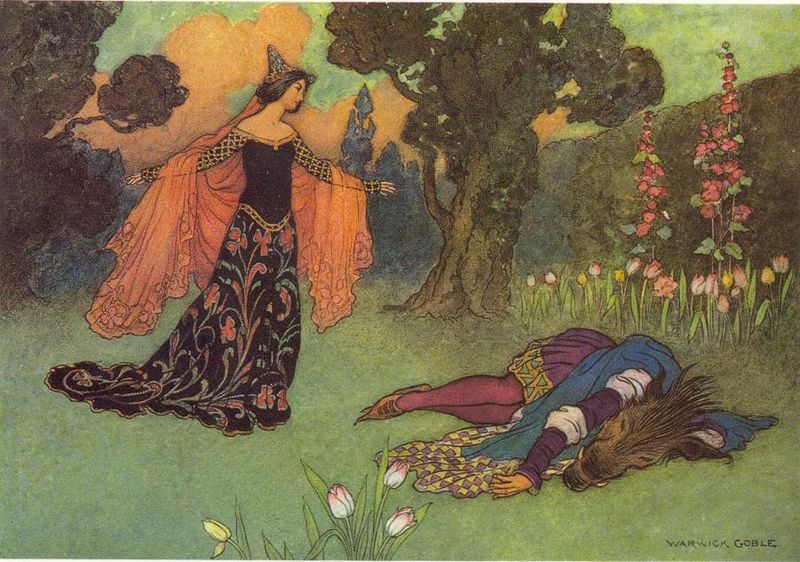
Traduzione by CHIARA GALIAZZO, volontaria di English Gratis. Il testo originale è tratto da una pagina del sito inglese di Wikipedia ed è disponibile nel rispetto della licenza Creative Commons Attribution 2.5 ![]() photo credit
photo credit
FAIRY TALE
LE FIABE
A fairy tale is a type of short story that typically features folkloric fantasy characters, such as fairies, goblins, elves, trolls, dwarves, giants, mermaids, or gnomes, and usually magic or enchantments.
Una fiaba é un genere di racconto breve che si caratterizza tipicamente per dei folcloristici personaggi di fantasia come le fate, i folletti, gli elfi, i troll, i nani, i giganti, le sirene o gli gnomi e di solito per l’elemento magico o gli incantesimi.
However, only a small number of the stories refer to fairies.
Tuttavia, solo un esiguo numero di fiabe si riferisce alle fate
The stories may nonetheless be distinguished from other folk narratives such as legends (which generally involve belief in the veracity of the events described) and explicitly moral tales, including beast fables.
Tuttavia, le fiabe possono essere distinte da un altro genere di narrativa popolare, come le leggende (che generalmente implicano la credenza nella veridicità degli eventi descritti)e i racconti esplicitamente morali, come le favole (i cui protagonisti sono gli animali).
In less technical contexts, the term is also used to describe something blessed with unusual happiness, as in “fairy tale ending” (a happy ending) or “fairy tale romance” (though not all fairy tales end happily).
In contesti meno tecnici, il termine é usato anche per descrivere qualcosa di benedetto da un’insolita felicità, come in un “finale da fiaba” (a lieto fine) o una storia d’amore da fiaba (sebbene non tutte le fiabe hanno un lieto fine)
Colloquially, a “fairy tale” or “fairy story” can also mean any far-fetched story or tall tale; it’s used especially of any story that not only isn’t true, but couldn’t possibly be true.
Nella lingua parlata una fiaba può anche riferirsi ad una storia irrealistica o ad una frottola, è usata specialmente per qualsiasi storia che non solo non è vera, ma non potrebbe nemmeno esserlo.
>>> In cultures where demons and witches are perceived as real, fairy tales may merge into legends, where the narrative is perceived both by teller and hearers as being grounded in historical truth.
Nelle culture dove i demoni e le streghe sono percepiti come reali, le favole possono mescolarsi con le leggende, dove il racconto é percepito sia dal narratore sia dagli uditori come se fosse basato sulla verità storica
However, unlike legends and epics, they usually do not contain more than superficial references to religion and actual places, people, and events; they take place once upon a time rather than in actual times.
Tuttavia, diversamente dalle leggende e dall’epica, le fiabe di solito non contengono altro che riferimenti approssimativi alla religione e a luoghi, persone ed eventi reali; esse sono ambientate in un tempo definito come c’era una volta, piuttosto che nel presente.
Fairy tales are found in oral and in literary form.
Le fiabe si trovano sia in forma orale che scritta
The history of the fairy tale is particularly difficult to trace because only the literary forms can survive.
La storia delle fiabe é particolarmente difficile da tracciare, perché solamente le forme letterarie riescono a sopravvivere
Still, the evidence of literary works at least indicates that fairy tales have existed for thousands of years, although not perhaps recognized as a genre; the name “fairy tale” was first ascribed to them by Madame d’Aulnoy in the late 17th century.
Tuttavia, la testimonianza delle opere letterarie indica almeno che le fiabe esistono da migliaia di anni, sebbene non siano state forse riconosciute come genere letterario. Il nome fiaba fu inizialmente attributo da Madame D’Aulnoy nel tardo 17° secolo.
Many of today’s fairy tales have evolved from centuries-old stories that have appeared, with variations, in multiple cultures around the world.
Molte delle fiabe di quest’oggi si sono sviluppate da racconti vecchi di secoli, che sono apparsi ,con diverse varianti, in molteplici culture in tutto il mondo
Fairy tales, and works derived from fairy tales, are still written today.
Le fiabe e le opere derivate da esse, vengono scritte ancora oggi.
The older fairy tales were intended for an audience of adults, as well as children, but they were associated with children as early as the writings of the précieuses; the Brothers Grimm titled their collection Children’s and Household Tales, and the link with children has only grown stronger with time.
Le fiabe più antiche erano destinate ad un pubblico di adulti, come pure di bambini, ma erano spesso associate ai bambini, come all’inizio i primi scritti che rientrano nel genere dei “les précieuses”. I fratelli Grimm intitolarono la loro collezione “i racconti dei bambini e delle famiglie” e il collegamento coi bambini è diventato solamente più forte con il tempo.
Folklorists have classified fairy tales in various ways.
I folcloristi hanno classificato le fiabe in vari modi.
The Aarne-Thompson classification system and the morphological analysis of Vladimir Propp are among the most notable.
il sistema di classificazione Aarme Thompson e l’analisi morfologica di Vladimir Propp sono tra i più degni di nota.
Other folklorists have interpreted the tales’ significance, but no school has been definitively established for the meaning of the tales.
Altri folcloristi hanno interpretato il significato della fiaba, ma nessuna scuola é stata definitivamente istituita per l’interpretazione del significato delle fiabe.


